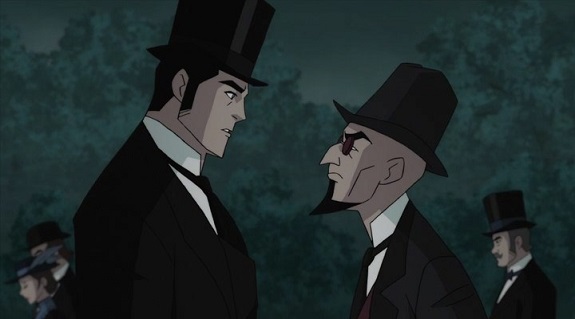 |
| Our first glimpse of Victorian Batman |
Two shadows have fallen over Victorian Gotham. One, a human-sized bat, has most criminals running, scared of its theatrical violence and bleakley absolute moral code. The other is Jack the Ripper, doing what Rippers historically just do, terrorizing those the state least cares to predict, especially poor, destitute women. Street justice and moralistic judgement personified. These forces will inevitably come into conflict; they must. Our only question is, which will ultimately represent Gotham’s beleaguered soul?
The 2018 movie Gotham By Gaslight copies the premise, but not the story, of Brian Augustyn and Mike Mignola’s 1989 comic of the same title. Resetting Batman in America's Gilded Age, the time that most resembled the economic inequality which birthed Batman, lets artists play around with bat mythology, keeping the core story intact, but stretching it to encompass larger themes. This movie is about Batman, but like good art everywhere, it’s also about us.
Batman launches his crime-busting enterprise by bringing the pain to a Fagin-like ringleader. So yeah, he initially aspires to simply fight street crime. But within moments, pained cries redirect him to a gruesome, precisely targeted murder. Batman quickly crosses paths with a female vigilante who shares his morbid interest in this crime. But the equally mysterious Selena Kyle has no patience for Batman’s theatrics. Women are dying, women like her, and someone needs to act.
Zach Snyder’s DC movies have faced much-justified criticism, including mine: their lack of heroic optimism, characterized by opponents as “cynicism,” seems to violate what superheroes do. This tone made sense in movies like Watchmen and 300, which dealt with desperate people in hopeless circumstances. But superheroes essentially require belief that something better than the present could potentially exist. Steampunk Batman apparently knows the difference between gritty realism and amoral nihilism, which Snyder’s antiheroes have forgotten.
 |
| Steampunk Batman and Selena Kyle square off, after intruding on one another's investigations |
Animation director Sam Liu presents a deeply principled Batman, aligned with municipal charities, steering street orphans to a local activist convent, picking fights with law enforcement when they’ve forgotten the meaning of justice. Remarkably, Liu also shows Batman getting his ass kicked: both Selena Kyle and the Ripper are equally prepared for a fistfight. Worse, as we increasingly realize, the Ripper’s ethical motivations run as deep as Batman’s, making both men’s violence equally, brutally incorruptable.
Batman’s appeal has long centered on the fact that he doesn’t have to care. Rich and opulent, he could relax in the luxuries his money could afford, as many did in the 1930s, when the character debuted. This alternate universe makes clear this still applies: in a Gotham so impoverished that men turn to theft, and women to prostitution, just to eat, the city’s wealthy look forward to a richly appointed and cosmopolitan World’s Fair.
Yes, Bruce Wayne need not care. He need not let anybody into his inner circle. But he does: besides employing street urchins and permitting conspiracy theorists to spout their crackpot theories in his ear, Wayne’s closest ally is a nun, Sister Leslie, who has nurtured countless Gotham foundlings. When poor, desperate women are murdered in alleyways, Wayne takes their deaths personally. Unlike Snyder’s gratuitously brutal Batman, this Batman cares, even though he doesn’t have to.
Because Batman cares, he inspires others to care too. Near the beginning, as stated, Batman rescues three urchins from their Fagin-like ringleader. These urchins are named Dickie, Jason, and Timmy—a deliberate reference for comics aficionadoes. When Batman rescues them, they’re desperate, scared thieves, and they quickly return to that life, because it’s what they know. But it doesn’t take long before they’re participating in Batman’s crusade, even when common street wisdom says to run.
 |
| Bruce Wayne gets handed an important clue by Dr. Hugo Strange |
This doesn’t come without contradictions. Supporting characters lavishly praise the World’s Fair (and Bruce Wayne’s financial support) in early scenes, that veteran fans realize, by the end, it will burn. The only question is how. The thing Wayne’s money has created, Batman’s pulp justice must destroy. In the end, one of Batman’s young Robins says: “It was all phony anyway. We'll make somethin' new, somethin' better.” And we, the audience, think: yeah, we probably will.
Comic-book mythology generally has one underlying ethic: a pure heart, backed with well-placed violence, can restore justice, eventually. That’s what Steampunk Batman does, too, bringing the beat-down in honor of those abandoned by society and economics. He identifies an enemy and pummels him into submission, restoring hope to Gotham's hopeless.Yet he does more, too. By caring when he doesn’t have to, and fighting when he could lose, he gives us permission to believe again.
No comments:
Post a Comment